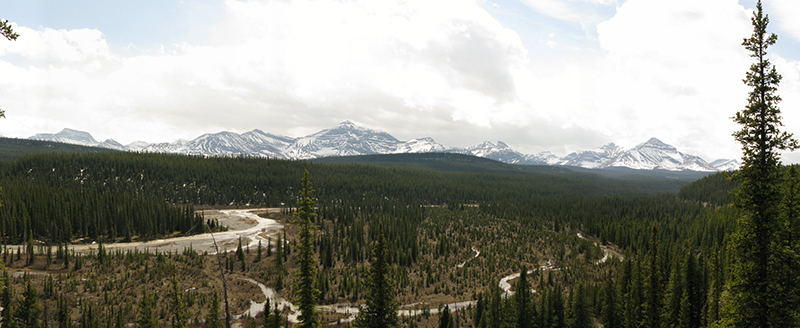
Clifford Cardinal guided hikers through a visual quest that included learning about Aboriginal traditions (Photo: Richard Siemens).
Canada's National Aboriginal Day is held annually on June 21 to celebrate the unique heritage, diverse cultures, and outstanding achievements of the nation's Aboriginal peoples.
Within these celebrations, Clifford Cardinal, Assistant Professor, Aboriginal Health, Department of Family Medicine helped organize a small group of dedicated hikers to embark on a guided, spiritual climb of Mount Cardinal in Jasper National Park on June 10.
The planned six-day climb was not only a unique chance to know more about Indigenous traditions, including natural health remedies commonly used in Aboriginal culture, but also a journey of self-reflection and personal goal setting.
Cardinal joined the University of Alberta in 2006 on a mission to make traditional Aboriginal health knowledge available to students wishing to expand their medical training. His elective, Traditional Health Practices, has applicants from as far as Dalhousie University eager to better understand Indigenous people, the culture and its health belief models. "My course is one of very few offered across the country," Cardinal says. "People want to learn and it shows. I wish we could take more people on - and more people on the climb."
Prior to this course, Cardinal taught at Blue Quills First Nations College in Saint Paul, Alberta and has been involved in numerous Indigenous initiatives, including the Mother Earth's Water program with Drs. David Suzuki and David Schindler.
The first climb of Mount Cardinal that he facilitated happened in 2006 and took three years to plan.

"At first, the climb was about the mountain being reclaimed," Cardinal says. Up until 12 years ago, Mount Cardinal was known as Mountain Park, in reference to a nearby town that had been abandoned since 1950. "We wanted to celebrate it coming back to our family. As more people heard about the climb and became interested, we realized that we should make it something bigger and changed the objectives."
Cardinal decided to expand the climb to bring in a key part of his culture -in a way that makes it much more personal for each participant.
"We decided to structure the climb like a vision quest, which traditionally is a journey that helps you find your purpose in life or in your place in your community," he explains. "It's something that has been done with my people before, but it's catching on again. Many who are battling addictions or personal problems have followed the same idea to help deal with their problems -they've walked, camped out, and fasted. "
"We made sure that the participants knew that even the attempt of reaching the summit was a huge and momentous achievement. With this climb, you're visualising your goals high above you at the summit and you get closer with each shaky step."
Each of the climbers were instructed to set their own personal goals as to why they were climbing the mountain; some wanted to overcome personal obstacles while others wanted to raise awareness to issues in their communities. Cardinal's personal goals were to do a good job when he joined the University of Alberta.
Throughout the journey to the summit, the climbers would share their aspirations and their problems through sharing circles, guided by a Holy Man who joined them for the trip.
"The sharing circles were a daily event," Cardinal says. "Even if it was just to talk about the day, they were important. Some people wanted to turn back at times because they were scared. It's a tough climb but we all got through."
Cardinal made sure that climbers knew well ahead of time that this wasn't going to be an easy task. Mount Cardinal's summit is 8,251 feet (in comparison, Whistlers Mountain is 8,084 feet) meaning acclimatizing to the air pressure was a concern. The climbers took a zig-zag route to lessen the impact of the incline.
"We had a photographer and writer join us on that first climb and document the experience," Cardinal says. "They took over 500 photos through the whole trip - but by the time we reached the summit, it was decided that we didn't want the Sacred Circle ceremony to be documented. That was a special moment for all of us and we wanted to respect it."
The first climb was ultimately a huge success. It brought together members from nearly a dozen Cree bands from across western Canada and even from as far south as Montana. Many of them carried goals to improve the lifestyles of their communities-whether it was to face their addictions, or to stop family violence and lateral violence, among other resolutions and desires. Over the past ten years Cardinal has received tremendous follow-up stories from most of the participants.
"We had two nurses on the climb who were well into their careers," Cardinal says. "Their goal during the climb was to decide whether to pursue a higher education - to leave jobs they were comfortable with to better themselves. Since the climb, they've both pursued and have earned their PhDs."
A decade following the first climb, some of these issues are still affecting the aboriginal community - the tragedies in La Loche, Saskatchewan earlier this year and in the Attawapiskat First Nation of Ontario are still at the front of everyone's minds. But the desire to improve and move forward is stronger than ever and represented in the goals of this year's climbers, with some travelling from as far as Australia to take part.
More than 200 people applied to the 2006 climb; since Cardinal first advertised the 2016 climb, he received over 300 applications.
"I'm glad that it's receiving so much interest, especially because it's the only major Aboriginal event that is connected to the University of Alberta," Cardinal says. "It certainly shows that people want to learn more."
If you want to know more about today's celebration, check out the National Aboriginal Day activities happening in Edmonton these days.